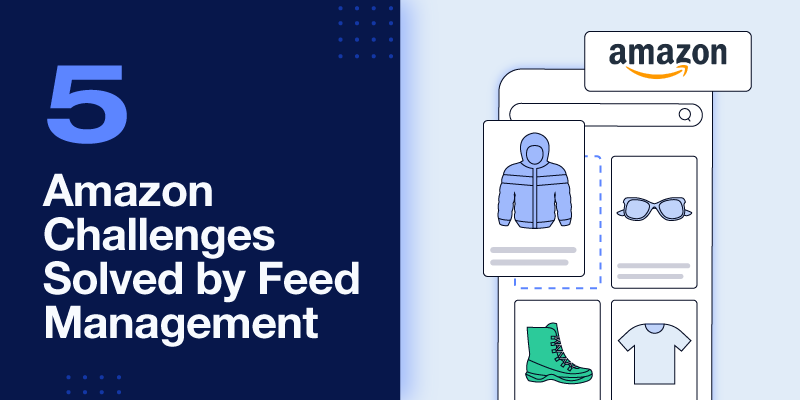Amazon is the elephant in the room for any business that’s looking to grow in ecommerce. Elephants are massive, powerful creatures, but if you’re not careful, you can get run over.
Nearly 60% of consumers said they shopped a lot or exclusively on marketplaces in 2021, but Amazon sellers have to overcome a number of challenges before they can take advantage of an ever-growing customer base.
These are the top five we often see.
1) Listing products on Amazon
Let’s assume you did the necessary preparation to become a marketplace seller, such as tracking inventory, taking good product photos, and registering as a brand owner (if applicable). Now it’s time to upload your catalog to Amazon.
Listing products one by one
You can create new product listings one by one, manually entering required information about each product into Amazon’s data fields. You can also search for a product on Amazon to see if a listing for it already exists under another seller. If the product is already listed, you can’t create a brand new listing for it, but you can update the inventory, shipping options, and price for your own offering.
However, listing products one at a time is impractical if you have more than a few dozen products, and sellers with large catalogs often opt for the bulk upload method.
Listing products in bulk
Using a bulk upload allows you to submit multiple products at once in a spreadsheet, but is this truly a time saver? Not really. You must download the individual listing templates for every category of product, then make sure you submit valid values in the format Amazon requires.
How a feed management solution helps you list products
Many sellers do not have a direct integration between their ecommerce platforms and Amazon, so they either manually upload catalog files to Amazon, or they find a product feed management solution that connects their data to the marketplace.
Feedonomics, for example, imports a seller’s raw product data into its platform to create unique marketplace exports from a single catalog. Product data is refreshed on a schedule, so whenever a merchant adds new products or wants to make changes to the listings (like offering a sale), the marketplace catalog is updated as well.
Connecting to Amazon is only part of the equation. Many sellers have difficulty changing their raw product data to match Amazon’s requirements. Categorizing products according to Amazon’s taxonomy takes time, and if not done correctly, the products don’t appear where shoppers expect to find them.
Adam Miles, the Chief Revenue Officer at Crazy Skate Co., experienced firsthand how time-consuming the catalog creation process is, especially for a business that’s selling products in many places.
“I used to manage the catalog myself on every marketplace, which was very time-intensive,” Miles said. “Spreadsheets for days, for every sales channel. It was a full-time job.”
Considering Miles’ real full-time job was to focus on revenue growth, managing the product catalog for marketplaces was something he chose to offload to Feedonomics. According to Miles, this saved Crazy Skate Co. 20 hours per week on feed management and allowed him to devote attention to strategic goals.


Related case study
Relieving Marketplace Headaches With Dedicated Feed Support
2) Optimizing product catalogs for Amazon
You must fulfill all of Amazon’s basic requirements to start selling, but if you want to stand out from the competition and reach more customers, it’s best to optimize your product listings further.
An optimized product listing includes an informative title, bullet points of key features, clean descriptions, and a high rate of filled attributes. You get your products listed by filling in the required attributes, but optional attributes can become mandatory at any moment, so it’s wise to supply optional attributes to future-proof your listings.
Including optional attributes also improves search results. Log into your seller portal and look at the listings quality dashboard to see the attributes Amazon recommends adding to your listings, such as material, model year, and other category-specific suggestions.
Amazon sellers also struggle with the creation of parent and child product relationships. For example, if you’re selling a robe in multiple colors, it’s better to show all the variations of your robe on a single parent page, rather than split them into individual pages. This allows customers to see everything you offer at a glance, rather than search for options that may not exist and get sidetracked.

How a feed management solution helps you optimize listings
A good feed management solution connects your product data to online shopping destinations around the world and helps you get the most out of that data. Some of the best practices for product listing optimization are publicly available—we’ve even published them ourselves—but implementing those best practices takes time and specialization.
Whether you choose to keep things in-house or find outside help, you need people with marketplace expertise to ensure your listings are consistently optimized, even as you add new products. Having a team dedicated to feed management can go a long way.
Cesar Piñon, Digital Marketing Manager of Swanson Health, is familiar with many of the best practices for ecommerce listings, but still found value in the support from a full-service solution like Feedonomics.
“We use several different feeds for an array of marketplaces and are always making adjustments to individual data sets,” Piñon said. “For bigger projects, the Feedonomics team is ready at a moment’s notice to support. The team is knowledgeable and provides insights that may be overlooked when working with testing and optimizations.”
3) Resolving listing errors on Amazon
Amazon sellers know that errors are basically inevitable when first uploading products to Amazon. Errors are triggered by a variety of issues, such as surpassing the character count limit for various fields, HTML in descriptions, missing attributes, invalid values, password-protected image servers, and more. It’s not uncommon to have multiple issues for a single listing.
Unfortunately, reaching Amazon support or resolving a case can be difficult. If you don’t know what is causing your errors, it takes some trial and error to diagnose the problem. It also requires persistence to reach a human being at Amazon if you need help with an urgent error, like a price change that is failing to update.
How a feed management solution helps you resolve errors
The quickest way to resolve errors is preventing as many as you can. You can’t possibly predict every error, so having experience and familiarity with Amazon’s error codes and fixes is extremely valuable to a business. It takes time to become a proficient feed-error resolver.
This was another reason Miles chose Feedonomics’ full-service solution for marketplaces to help him with Crazy Skate Co.’s product feeds.
“We’d been talking about hiring someone to handle the support issues, but the main reason we didn’t is because it’s such a specialized thing, dealing with all the different marketplaces,” Miles said. “It just seemed like such a time-suck, bringing someone up to speed on that.”
With plans to expand to more marketplaces, Miles anticipated the company would need additional specialists to manage feeds for every new channel. When an in-house feed specialist leaves your company, it can be difficult to hit your revenue goals. By partnering with a company that specializes in feed management, you ensure business continuity and unlock scalable growth.

4) Managing orders on Amazon
Managing your orders is a big deal. Your customers have already spent their money and are eagerly awaiting your product. If you fail to deliver on their expectations, you face the backlash of someone who is emotionally and financially invested.
Beware of overselling
Overselling refers to when shoppers purchase a product that’s no longer in stock. Delayed updates between your inventory management system and marketplace, no matter how short, make this possible. If you cancel too many orders, Amazon suspends your account.
Act quickly on your orders
Amazon is popular in part because of its convenient shopping experience, so Amazon takes its reputation seriously when it comes to fulfillment.
If you manually manage your orders by logging into Seller Central, you’re undertaking a tedious process that increases the opportunity for human error and delays. However, even sellers who use an automated solution for order management can run into trouble with unreliable technology and unresponsive tech support.
Kaleb Quist, Digital Marketing Specialist at Stone Coat Countertops, watched the company’s reputation take a hit on social media when the service that facilitated its order management stopped feeding orders correctly. When he reached out to customer service for help, the response was inadequate.
“They fumbled the ball. They were difficult to get a hold of, and their order integration service was sloppy,” Quist said. “It could take hours or even days for orders to feed back into our system, and the delay caused our customers to receive their packages far later than the projected delivery date. This led to some serious headaches for us.”

How a feed management solution helps you manage orders
With goals of global expansion and a brand image to protect, Quist said that finding a reliable solution for managing orders on Amazon became a priority. He was already spending too much trying to resolve listing errors, and with a broken fulfillment system, the process was not sustainable.
Stone Coat Countertops turned to Feedonomics for help with order management and listing errors, resulting in improved customer satisfaction, fewer negative reviews, a decreased refund rate, and a late shipment rate that was cut in half.
A reliable feed management solution helps businesses streamline operations and automate order fulfillment. The platform you use should have safeguards to alert you of missing inventory, and apply stock buffers to prevent overselling when you list the same products on several shopping channels.

Related case study
Closing Gaps in Order Management With a Full-Service Data Feed Solution
5) Expanding to new marketplaces
Maybe you’re running everything in house, and you feel really good about your current Amazon operations. Now it’s time to expand to additional marketplaces, like Walmart, eBay, and Target Plus. You managed to create a sustainable process for one marketplace, but doing it for several more would require you to visit a cloning facility.
Ticia Workman, the Director of Marketplace Growth at Groove Life, faced a similar challenge. The company already had a presence on Amazon and a workflow for managing business there. However, as a team of one, Workman knew that replicating the process for additional marketplaces was a huge undertaking.
“The sheer scope of the work was one thing,” said Workman. “Having to hand-create all of the listings, having to put in all of the images by hand, everything like that. Just thinking of having to do that for multiple different locations, with each one having its own set of rules, was something I’d rather not have to deal with.”

How a feed management solution helps you expand to new marketplaces
To succeed in ecommerce, you need a combination of powerful technology and experienced people supporting your efforts. As you grow, those needs multiply.
If you use a simple plug-in to send product data from your ecommerce platform to a marketplace, you probably won’t get a dedicated feed manager or knowledgeable tech support with it. When you run into problems with the feed, you’re at the mercy of an unknown developer and unspecified response times. If you plan to expand to new marketplaces, it’s rare to find a plug-in that reliably maintains feeds for multiple channels.
On the other hand, feed management is a business in its own right, and ecommerce companies shouldn’t be expected to build everything from the ground up just to sell their products. Managing everything in-house is expensive, cost-prohibitive, and a risk to business continuity.
A full-service feed management solution makes your multichannel goals attainable. By trusting a reliable feed platform and an experienced team to assist you with product listing and optimization, error resolution, order management, and data protection, you gain the freedom to focus on other revenue-driving initiatives.
Oh yeah, and what happened to Ticia Workman from Groove Life, you ask? You could say she found her groove.
After entrusting feed management to Feedonomics, the company expanded to five marketplaces in five months, with the sixth coming the following year.
“It’s given me time to think more strategically instead of reactively to issues going on,” Workman said. “I can kind of leave the day-to-day issues behind and focus on how to grow things and use my time more efficiently. That’s priceless, just being able to free mind space. It’s honestly been great.”

Related case study
Establishing a Brand Presence on Six New Marketplaces

With its leading data feed management platform, Feedonomics helps brands, retailers, and agencies optimize and list products on hundreds of shopping destinations around the world. Learn more about our full-service solutions for advertising channels and marketplaces.




